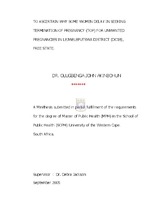| dc.contributor.advisor | Jackson, Debra | |
| dc.contributor.author | Akinbohun, Olugbenga John | |
| dc.contributor.other | School of Public Health | |
| dc.contributor.other | Faculty of Community and Health Sciences | |
| dc.date.accessioned | 2013-05-23T13:50:38Z | |
| dc.date.available | 2007/03/16 13:47 | |
| dc.date.available | 2007/03/16 | |
| dc.date.available | 2013-05-23T13:50:38Z | |
| dc.date.issued | 2005 | |
| dc.identifier.uri | http://hdl.handle.net/11394/207 | |
| dc.description | Master of Public Health - MPH | en_US |
| dc.description.abstract | Women of child-bearing age sometimes fail to plan for pregnancies. Often they discover that they are pregnant and are not prepared or cannot afford to raise the child. Before 1996 there was no choice for women as regards pregnancies, all pregnancies must be carried to term and delivered except on health grounds and with stringent conditions. However after the TOP act was enacted in 1996, women were allowed a choice of TOP up to and including 20 weeks of pregnancy. Regardless of the availability of choice of TOP, some pregnant women still present late (after 12 weeks) for TOP when the risks of complications and costs are higher. Women who present late for TOP usually have to be admitted to a district or regional hospital and managed. The costs at such institutions are high. TOPs before 12 weeks (early TOP) are done in a primary health care (PHC) facility (TOP center) and no admission is required hence less cost. Complications of early TOP are also very mild and rare. In Lejweleputswa district there is only one TOP Center (Kopano TOP Clinic) and this serves both Lejweleputswa and the Northern Free State districts. Early TOPs (less than 12 weeks) are done and completed at this center. Late TOPs (above 12 weeks but not more than 20 weeks) are initiated at this TOP center and referred to district or regional hospitals nearest to the patient’s home, in both districts for completion.Problems - An increasing number of women are seeking TOP service at late stages of pregnancies and the incidence of severe complications like severe bleeding, retained placenta, infection, amniotic fluid embolism, death etc, are increasing. The hospital’s bed space and budget are stretched to the limit due to the influx of late term TOP to the hospitals. Lack of manpower, especially doctors, in these hospitals also create some problems, as the few doctors available have to attend to other ill patients as well. Sometimes bleeding TOP patients are transfused with blood and placed on a waiting list for theatre and this often increases the risk of complications. The emotional effect of late TOP on hospital staff (doctors and nurses) are enormous as the expelled fetus are much more developed than in early TOP where no fetus is seen at evacuation with simple Manual Vacuum Aspiration (MVA). | en_US |
| dc.language.iso | en | en_US |
| dc.publisher | University of the Western Cape | en_US |
| dc.subject | Pregnancy | en_US |
| dc.subject | Unwanted | en_US |
| dc.subject | South Africa Free State | en_US |
| dc.subject | Abortion | en_US |
| dc.subject | Complications | en_US |
| dc.title | To ascertain why some women delay in seeking termination of pregnancy (TOP) for unwanted pregnancies in Lejweleputswa District (DC18), Free State | en_US |
| dc.type | Thesis | en_US |
| dc.rights.holder | University of the Western Cape | en_US |
| dc.description.country | South Africa | |

